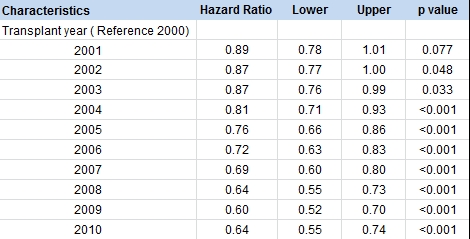Living Donor Kidney Transplant Outcomes Have Improved Over the Last Decade.
Medicine, University of Virginia, Charlottesville, VA.
Meeting: 2016 American Transplant Congress
Abstract number: 128
Keywords: Donation, Kidney transplantation, Outcome
Session Information
Session Name: Concurrent Session: Kidney Donor Surgery and Outcomes
Session Type: Concurrent Session
Date: Sunday, June 12, 2016
Session Time: 4:30pm-6:00pm
 Presentation Time: 5:06pm-5:18pm
Presentation Time: 5:06pm-5:18pm
Location: Ballroom B
Our group recently reported improved 6-month eGFR and long-term patient and allograft outcomes in deceased donor transplant over the last decade. Our goal was to investigate if similar trends were taking place in living donor (LD) transplantation.
All adult LD kidney recipients from 2000 to 2010 who had at least six months of graft survival were identified using the SRTR database. We used Kaplan-Meier and Cox proportional hazard modeling to determine if patient survival, graft survival, death-censored graft survival, and death with a functioning graft changed over this period. We used the six month creatinine to determine recipient eGFR by CKD-EPI (available in 94.6%).
61,817 adult LD kidney recipients were identified. Kaplan Meier analysis showed patient survival began to improve in 2003 and graft survival rates began to improve in 2004. Table 1 shows Cox proportional hazard modeling for graft survival between 6 month and 3 years. The hazard ratio for graft failure decreased to 0.64 (0.55-0.74, p<0.001) in 2010 compared to 2000. Figure 2 depicts the substantial improvement on patient survival during the last decade.
The hazard ratio for graft failure decreased to 0.64 (0.55-0.74, p<0.001) in 2010 compared to 2000. Figure 2 depicts the substantial improvement on patient survival during the last decade.  The median eGFR at 6 months improved from 55.9 in 2000 to 60.9 ml/min/1.72m2 in 2010. Adjusting for donor age, the median eGFR improved 11% over the decade. The frequency of CKD stage 3b, 4 and 5 at 6 months decreased by at least 60%. These changes occurred in the face of changing trends in immunosuppression towards predominantly tacrolimus (TAC) and mycophenolic acid (MPA) based regimens. By 2010, 86.6% of recipients were on TAC/MPA, whereas before 2003 less than 50% of them used this combination.
The median eGFR at 6 months improved from 55.9 in 2000 to 60.9 ml/min/1.72m2 in 2010. Adjusting for donor age, the median eGFR improved 11% over the decade. The frequency of CKD stage 3b, 4 and 5 at 6 months decreased by at least 60%. These changes occurred in the face of changing trends in immunosuppression towards predominantly tacrolimus (TAC) and mycophenolic acid (MPA) based regimens. By 2010, 86.6% of recipients were on TAC/MPA, whereas before 2003 less than 50% of them used this combination.
Six month eGFR, long-term graft and patient survival improved significantly during the last decade. The eGFR increased by ~5 ml/min/1.72m2 in spite of an aging donor pool. Immunosuppression changes over time likely played a key role in this improvement.
CITATION INFORMATION: Nishio Lucar A, Vranic G, Keith D. Living Donor Kidney Transplant Outcomes Have Improved Over the Last Decade. Am J Transplant. 2016;16 (suppl 3).
To cite this abstract in AMA style:
Lucar ANishio, Vranic G, Keith D. Living Donor Kidney Transplant Outcomes Have Improved Over the Last Decade. [abstract]. Am J Transplant. 2016; 16 (suppl 3). https://atcmeetingabstracts.com/abstract/living-donor-kidney-transplant-outcomes-have-improved-over-the-last-decade/. Accessed July 12, 2025.« Back to 2016 American Transplant Congress
